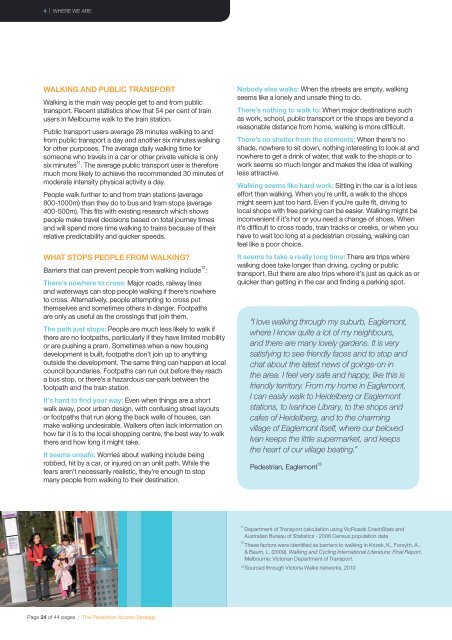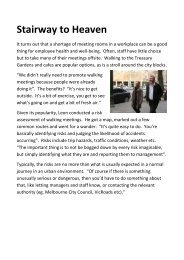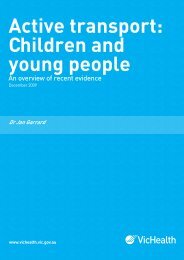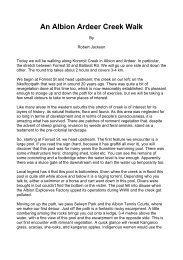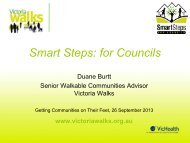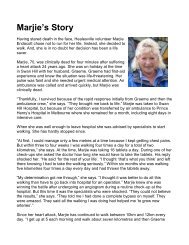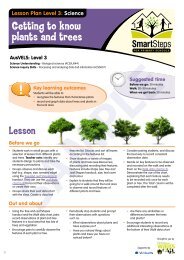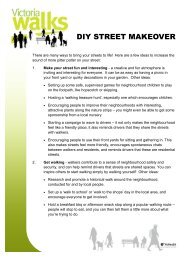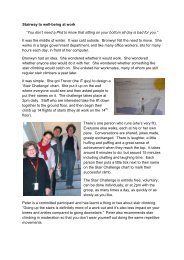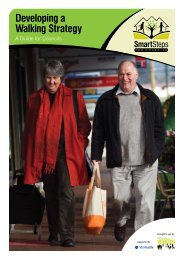Pedestrian Access Strategy 2010 - Victoria Walks
Pedestrian Access Strategy 2010 - Victoria Walks
Pedestrian Access Strategy 2010 - Victoria Walks
You also want an ePaper? Increase the reach of your titles
YUMPU automatically turns print PDFs into web optimized ePapers that Google loves.
4 | Where we areWalking and public transportWalking is the main way people get to and from publictransport. Recent statistics show that 54 per cent of trainusers in Melbourne walk to the train station.Public transport users average 28 minutes walking to andfrom public transport a day and another six minutes walkingfor other purposes. The average daily walking time forsomeone who travels in a car or other private vehicle is onlysix minutes 11 . The average public transport user is thereforemuch more likely to achieve the recommended 30 minutes ofmoderate intensity physical activity a day.People walk further to and from train stations (average800‐1000m) than they do to bus and tram stops (average400-500m). This fits with existing research which showspeople make travel decisions based on total journey timesand will spend more time walking to trains because of theirrelative predictability and quicker speeds.What stops people from walking?Barriers that can prevent people from walking include 12 :There’s nowhere to cross: Major roads, railway linesand waterways can stop people walking if there‘s nowhereto cross. Alternatively, people attempting to cross putthemselves and sometimes others in danger. Footpathsare only as useful as the crossings that join them.The path just stops: People are much less likely to walk ifthere are no footpaths, particularly if they have limited mobilityor are pushing a pram. Sometimes when a new housingdevelopment is built, footpaths don’t join up to anythingoutside the development. The same thing can happen at localcouncil boundaries. Footpaths can run out before they reacha bus stop, or there’s a hazardous car-park between thefootpath and the train station.It’s hard to find your way: Even when things are a shortwalk away, poor urban design, with confusing street layoutsor footpaths that run along the back walls of houses, canmake walking undesirable. Walkers often lack information onhow far it is to the local shopping centre, the best way to walkthere and how long it might take.It seems unsafe: Worries about walking include beingrobbed, hit by a car, or injured on an unlit path. While thefears aren’t necessarily realistic, they’re enough to stopmany people from walking to their destination.Nobody else walks: When the streets are empty, walkingseems like a lonely and unsafe thing to do.There’s nothing to walk to: When major destinations suchas work, school, public transport or the shops are beyond areasonable distance from home, walking is more difficult.There’s no shelter from the elements: When there’s noshade, nowhere to sit down, nothing interesting to look at andnowhere to get a drink of water, that walk to the shops or towork seems so much longer and makes the idea of walkingless attractive.Walking seems like hard work: Sitting in the car is a lot lesseffort than walking. When you’re unfit, a walk to the shopsmight seem just too hard. Even if you’re quite fit, driving tolocal shops with free parking can be easier. Walking might beinconvenient if it’s hot or you need a change of shoes. Whenit’s difficult to cross roads, train tracks or creeks, or when youhave to wait too long at a pedestrian crossing, walking canfeel like a poor choice.It seems to take a really long time: There are trips wherewalking does take longer than driving, cycling or publictransport. But there are also trips where it’s just as quick as orquicker than getting in the car and finding a parking spot.“I love walking through my suburb, Eaglemont,where I know quite a lot of my neighbours,and there are many lovely gardens. It is verysatisfying to see friendly faces and to stop andchat about the latest news of goings-on inthe area. I feel very safe and happy, like this isfriendly territory. From my home in Eaglemont,I can easily walk to Heidelberg or Eaglemontstations, to Ivanhoe Library, to the shops andcafes of Heidelberg, and to the charmingvillage of Eaglemont itself, where our belovedIvan keeps the little supermarket, and keepsthe heart of our village beating.”<strong>Pedestrian</strong>, Eaglemont 1311Department of Transport calculation using VicRoads CrashStats andAustralian Bureau of Statistics - 2006 Census population data12 These factors were identified as barriers to walking in Krizek, K., Forsyth, A.,& Baum, L. (2009). Walking and Cycling International Literature: Final Report.Melbourne: <strong>Victoria</strong>n Department of Transport.13Sourced through <strong>Victoria</strong> <strong>Walks</strong> networks, <strong>2010</strong>Page 24 of 44 pages | The <strong>Pedestrian</strong> <strong>Access</strong> <strong>Strategy</strong>


